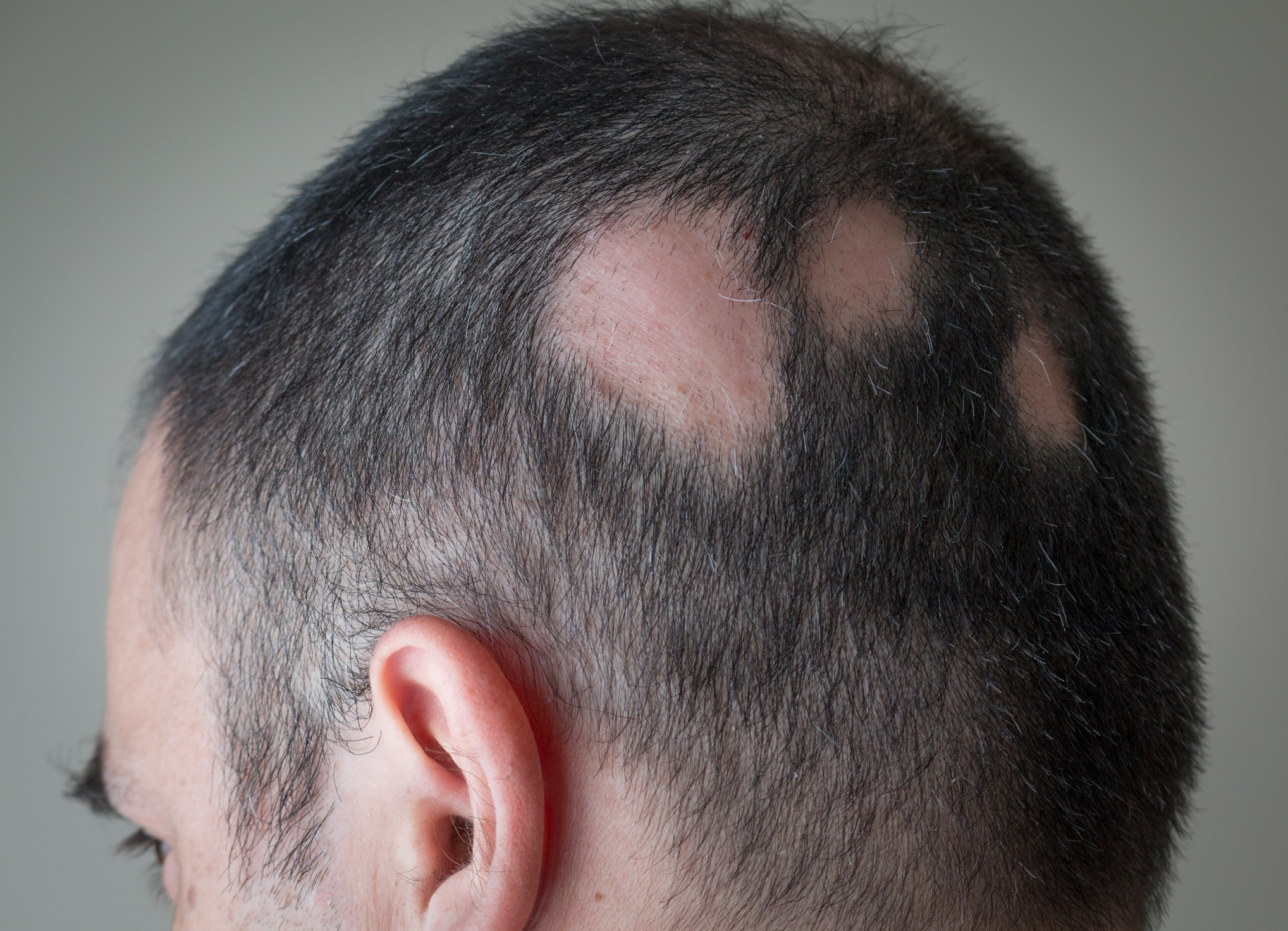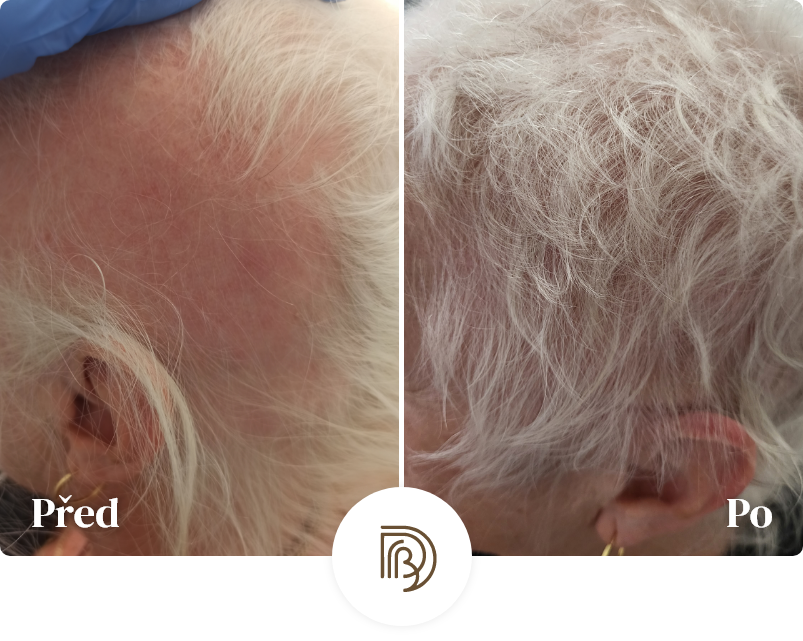
Article content
Alopecia areata (alopecia areata) is a common autoimmune disease that affects the hair follicles. It results not only in hair loss, but also in the loss of other hair on various parts of the body. However, the disease most commonly affects the scalp, where it produces the typical hair follicles.
Facts
- Alopecia areata affects approximately 2% of the population
- Typically manifested by bald patches in the hair or on other parts of the body
- It most often begins to manifest between the ages of 10 and 30
- Hair baldness caused by this disease manifests itself equally in men and women
- About half of patients can regrow hair without treatment
What is Alopecia areata?
Alopecia areata is an autoimmune disease. The patient’s immune system evaluates the hair follicles as a threat and begins to attack them. An immune reaction (inflammation) occurs and hair loss follows.
It is not a scarring form of alopecia, same as androgenetic alopecia. This means that the hair follicle is not destroyed and the possibility of hair regrowth is preserved.
Usually, bald deposits (hence the patchy hair loss) of oval shape of various sizes begin to form. In the case of smaller deposits, in some cases the hair may grow back spontaneously without treatment. However, if there are larger or multiple deposits on different parts of the scalp or other hairy parts of the body, the chances are lower.
Alopecia areata is further divided into:
- Alopecia universalis
- Alopecia universalis represents the most extreme form of alopecia areata. While alopecia areata causes localised bald patches and alopecia universalis leads to the loss of all hair on the head, alopecia universalis goes even further – itcauses the complete loss of all body hair.
People with alopecia universalis lose not only the hair on their head but also eyebrows, eyelashes, nose and ear hairs, beard, and all body hair including armpit hair, pubic hair and fine hair on the arms and legs. This condition can develop suddenly or gradually progress from alopecia areata or alopecia totalis.
- Alopecia universalis represents the most extreme form of alopecia areata. While alopecia areata causes localised bald patches and alopecia universalis leads to the loss of all hair on the head, alopecia universalis goes even further – itcauses the complete loss of all body hair.
- Alopecia totalis
- Alopecia totalis is a more severe form of alopecia areata, in which there is a complete loss of hair on the head. While alopecia areata typically manifests as oval-shaped bald patches, alopecia totalis leads to complete hair loss over the entire surface of the head, sometimes including the eyebrows and eyelashes.
- Diffuse alopecia areata
- Diffuse alopecia areata is a lesser known but important variant of alopecia areata. Unlike the classic form, which manifests as bright bald patches, diffuse alopecia areata causes overall hair loss over the entire head without producing distinct bald areas.
This type of alopecia can easily be confused with other forms of hair loss, such as androgenetic alopecia or telogen effluvium. The key difference is that in diffuse alopecia areata , there is a sudden and marked thinning of hair over a period of weeks to months, whereas other forms of hair loss are usually more gradual.
- Diffuse alopecia areata is a lesser known but important variant of alopecia areata. Unlike the classic form, which manifests as bright bald patches, diffuse alopecia areata causes overall hair loss over the entire head without producing distinct bald areas.
- Ophiasis
- Alopecia areata ophiasis is a rare but very characteristic variant of alopecia areata. In alopecia areata ophiasis, hair loss occurs in a snake or wave-shaped band that extends from the lower occipital region (back of the head) through the area behind the ears to the temples. This pattern creates a conspicuous hairless band around the edge of the hairline, while the rest of the hair on the head may remain intact.
Symptoms and manifestations of Alopecia areata
The primary symptom of alopecia areata is the appearance of round or oval bald patches in the hair on the scalp. In some cases, these bald patches can also appear on the face – for example, on the eyebrows, eyelashes and beard, but also elsewhere on the body. The affected areas are usually smooth, hairless and the skin remains normal without any redness or scaling.
The exact cause of alopecia areata is not fully understood. Genetic factors, family history and environmental influences may play a role. In addition, there is evidence that stress, hormonal imbalances and other autoimmune diseases may also contribute to some extent to the onset or recurrence of alopecia areata.
Alopecia areata in children
In up to 50% of cases, patients start to grow hair without treatment within a year. However, the course is difficult to predict. Even after apparently successful hair regrowth after treatment, relapse often occurs.
Treatment of adolescent patients with alopecia areata is possible, but mainly due to the unpredictable recurrences mentioned above, it is a long-term process. Childhood and adolescent patients are often frustrated and suffer from loss of self-esteem, social isolation and depression. Therefore, I recommend not to underestimate this issue and to find them a good child psychologist.
The most common myths and facts about alopecia areata
Myth: Alopecia areata is caused by stress.
Fact: Although stress can trigger an episode or worsen symptoms, it is not a direct cause of the disease. Alopecia areata is an autoimmune disease with complex genetic and environmental factors.
Myth: Alopecia areata only affects the hair on your head.
Fact: Although most visible on the head, alopecia areata can affect any area of the body where hair grows, including eyebrows, eyelashes, beard and so on.
Myth: Alopecia areata is caused by poor hygiene or hair care.
Fact: This disease has nothing to do with personal hygiene or hair care. It is an internal problem of the immune system.
Treatment of alopecia areata
Treatment of alopecia areata consists of two steps. The procedure for treating alopecia alopecia is similar in both men and women.
In the first stage, it is necessary to suppress the body’s immune response, eliminate inflammation and prevent further hair loss. Corticosteroids are typically used and can be administered topically, orally or by injection. In addition, topical immunotherapy can be used, in which a substance called diphencyprone (DPCP) is applied to the affected areas. The aim of this treatment is to induce an allergic reaction in the body. This has been shown to suppress the body’s immune response to the hair follicles.
In the second phase, new hair growth needs to be encouraged, either with topical preparations or oral medications. Most often, but not always, it is used Minoxidil. This is combined with other methods to promote hair growth, such as plasmatherapy, mesotherapy, microneedling and others.
In 2022, the FDA approved a drug called Baricitinib to treat severe forms of alopecia areata. It is the first drug ever approved to treat AA. This drug is not yet standardly available for the treatment of alopecia areata in the Czech Republic, however, under certain conditions it can be administered in biological treatment centres. The drug Ritlecitinib was also approved in 2023. Deuruxolitinib was also approved in 2024.
It is important to note that the effects of each method of treating alopecia areata vary dramatically from patient to patient. It is therefore advisable to consult a dermatologist specialising in hair problems, as only he or she can determine the most appropriate approach based on individual circumstances.





